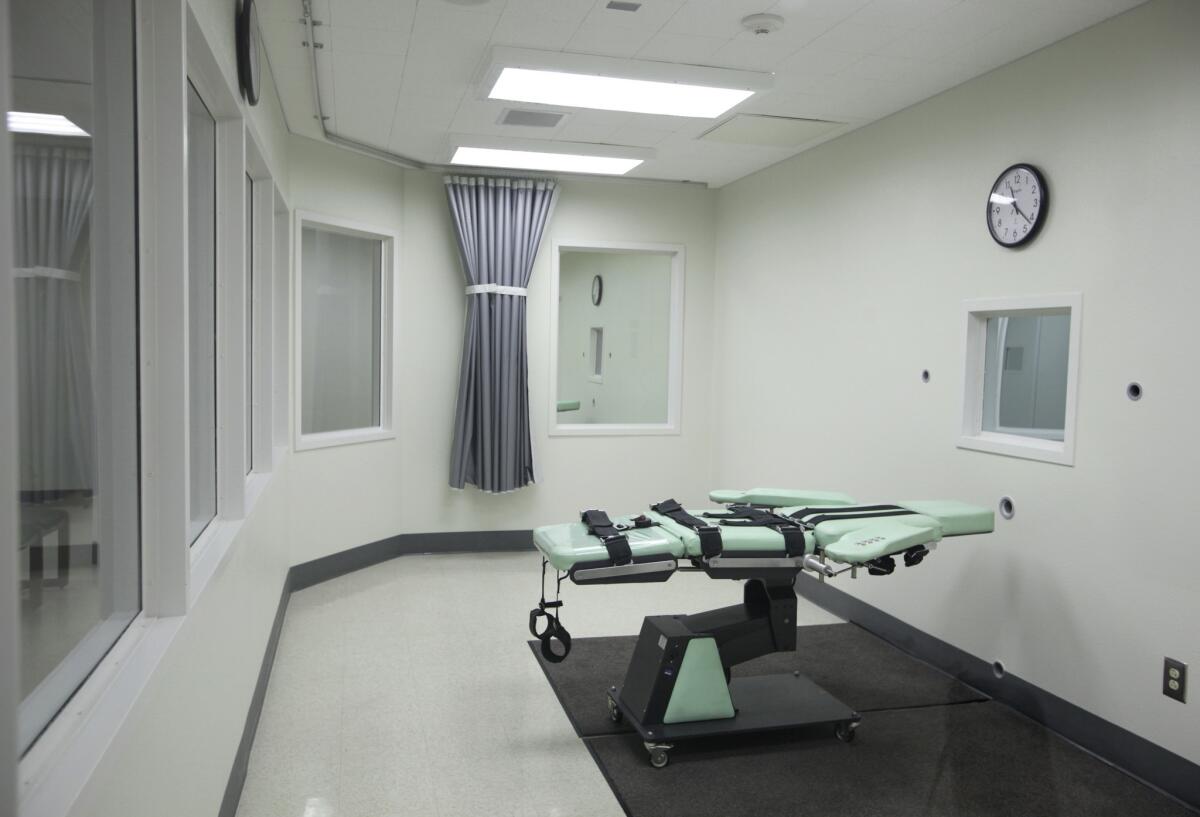Proposed lethal injection drugs once hailed as ‘sleep cures’

A three-drug procedure had been used in executions in California. One of the four drugs on the new list, thiopental, had been part of that earlier lethal-injection protocol.
- Share via
A list of four new lethal injection drugs proposed by the state of California on Friday all belong to a class of medications that once promised an end to anxiety, sleeplessness and certain mental illnesses but are now routinely used to end the lives of both the guilty and the innocent.
The drugs — amobarbital, pentobarbital, secobarbital and thiopental — are all barbiturates and, depending on the dose, can either induce a sound slumber or eternal sleep.
They are routinely used to euthanize dogs, horses and other animals, and are sometimes sought on the black market by those who hope to end the suffering of the terminally ill.
Pentobarbital, better known by its brand name Nembutal, was the drug authorities believe Marilyn Monroe used to commit suicide. An empty 50-capsule bottle of the drug was found on the nightstand beside her naked corpse on the morning of Aug. 5 1962.
Her personal physician, Hyman Engelberg, told the Los Angeles Times that the drug was prescribed several days earlier and that she was instructed to take only one a night to help her sleep.
Today, pentobarbital and the more expensive secobarbital are the most commonly prescribed drugs in physician-assisted suicides. According to the Oregon Public Health Division, the drugs were used in 99% of all assisted suicides since passage of the state’s Death With Dignity Act in 1997.
Barbiturates depress the central nervous system by mimicking, or enhancing, the effects of specific neurotransmitters, which are naturally occurring chemicals that enable nerve cells to communicate with each other.
While some neurotransmitters excite communication, others — such as gamma-aminobutyric acid, or GABA — act to inhibit it. When barbiturates are administered to humans and other mammals, the nervous system mistakes it for GABA and slows everything down.
Depending on the dosage, barbiturates can ease anxiety, induce sleep, combat seizures, lower blood pressure or halt breathing.
All of the drugs on the protocol list were developed prior to World War II, and most were greeted as “sleep cures,” anti-anxiety drugs and sedatives. Pentobarbital was also considered to be a remedy for epileptic seizures.
But as their use became more widespread, it was clear they had major drawbacks: dependence and death by overdose.
“Among the paradoxes of destiny is the possible death through overdose of the two scientists who introduced the first bartbiturate ... after some years of dependence upon these substances,” according to a review article by Francisco Lopez-Muñoz, a pharmacology researcher at the University of Alcala, in Madrid, Spain, and colleagues in the journal Neuropsychiatric Disease and Treatment.
As overdoses and cases of addiction mounted, governments began barring their use as sleeping pills and sedatives in the 1960s.
Today, barbiturates are used for much more specific medical purposes, such as calming patients prior to surgery, emergency treatment of convulsions and managing traumatic brain injuries.
Under California’s newly proposed protocol, only one drug will be used, although that drug will be selected on a case-by-case basis.
The final drug listed in the proposal, thiopental, was actually used in the former lethal-injection protocol, but in concert with two other drugs: pancuronium bromide and potassium chloride.
The three-drug protocol began with injections of thiopental so that the condemned inmate lost consciousness. Next, pancuronium was injected to paralyze the inmate’s skeletal muscles and prevent breathing. Finally, a large dose of potassium chloride was injected to stop electrical activity in the heart and bring its beating to a halt.
In reality, a heavy dose of thiopental itself will cause death in most people by impairing respiration and starving the heart and brain of oxygen, according to a paper written by Dr. Mark Dershwitz, a professor of anesthesiology at the University of Massachusetts, and Dr. Thomas Henthorn, an anesthesiology professor at the University of Colorado, Denver.
Doses that would normally cause death are sometimes used in patients during brain surgery, to interrupt blood flow. In these situations, the patient is hooked up to mechanical life support.
“While neither of us, nor any other physician we know, has ever given a 3000-mg dose of thiopental to a patient who was not mechanically ventilated nor had his or her circulation supported, it is difficult for us to imagine that the administration of 3000 mg of thiopental to an inmate, by itself, is survivable,” the authors wrote in the Fordham Urban Law Journal.
Although the state has listed four possible drugs to use in executions, it remains unclear whether officials will actually be able to obtain them.
Manufacturers of the drugs have refused to provide them for the purpose of executions, and competitive demand has also grown among those seeking them for physician-assisted suicides.
Last month, California joined Oregon, Washington and Vermont in legalizing physician-assisted suicides. A court ruling also allows physician-assisted suicide in Montana.
-------------
For the record
10:10 a.m.: An earlier version of post reported that physician-assisted suicide was legal in New Hampshire. It is not.
-------------
Twitter: @montemorin







